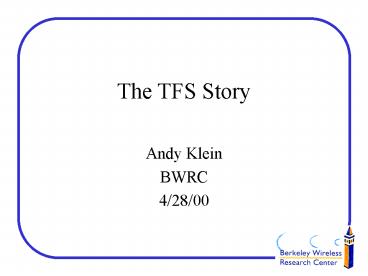The TFS Story - PowerPoint PPT Presentation
1 / 12
Title:
The TFS Story
Description:
A downlink design: Hornet* Goals: ... (Hornet) user 1. user 2. user 3. user 4. user 5. user 16. Conclusion ... Have proposed a specific implementable system: Hornet. ... – PowerPoint PPT presentation
Number of Views:24
Avg rating:3.0/5.0
Title: The TFS Story
1
The TFS Story
- Andy Klein
- BWRC
- 4/28/00
2
Once upon a time. . .
- Feb 1999
- BWRC opens for business, with the Universal Radio
(UR) listed as one of 3 design drivers. - An ambitious radio design that allows for
uncoordinated co-existence with other radios. - Adapts to provide requested service given type of
service, location, and dynamic variations in
environment (i.e. number of users). - Allows for continuous upgrades to support new
services as well as advances in communication
engineering and implementation technologies.
3
The USS era
- June 1999
- Spectrum sharing is identified as the key
challenge for the UR. - UR driver evolves from a radio design into a
spectrum management initiative, and is renamed
"Universal Spectrum Sharing" (USS). - USS study group is formed to investigate strategy
for uncoordinated use of spectra without loss in
capacity. - Simultaneously exploit time, frequency, space.
- Main goal change the way spectrum is allocated.
4
USS Guidelines
- Fall, 1999
- Several guidelines proposed for spectrum sharing
- Use transmit power as a constraint which
encourages good behavior - Good behavior means
- localization in temporal-frequency-spatial
signal space which allows other users to coexist
without interference - stationary or predictable behavior which
facilitates adaptation by other users - alignment to a time and frequency structure
which facilitates co-existence
5
USS difficulties
- Jan, 2000
- We had no rigorous results for the difficult
problem of spectrum sharing -- we only had
guidelines. - This may stem from lack of results in information
theory. The interference channel has not yet
been solved" by information theorists -- even
for the seemingly simple Gaussian case - Realized that we needed to refocus our efforts on
what we do best designing radios. - Then, as we were hastily preparing slides 10
minutes before Retreat2k, the idea came to us. . .
6
Time
Space
Enter the TFS Radio. . .
Simulink
Frequency
is
our
friend!
7
So what is the TFS Radio?
- A general framework that describes a wide range
of next-generation communications algorithms - Incorporates three key features common to all
next generation indoor systems - multiple-access capability
- resistance to multi-path fading
- high bandwidth efficiency
- Leads to feasible designs while maintaining an
appropriate level of generality
8
TFS transmitter
A
A
transpose
transpose
N
1
MEA
N
1
Coding and modulation
spreading, S/P
1
1
1
A
A
N
2
MEA
2
N
spreading, S/P
2
2
2
AN
bits
. . .
. . .
. . .
N
N
A
A
spreading, S/P
A
A
A
N
MEA
from Rx
N
A ? of antennae N ? of carriers ? of users
user 1
user 2
. . .
user k
9
TFS receiver
to Tx
A
A
transpose
transpose
N
1
MEA
N
1
Decoding, detection, decision making
despreading
1
1
FFT
remove cyclic prefix, pulse shape
S/P
1
1
A
A
N
2
MEA
N
2
despreading
2
2
FFT
S/P
2
2
remove cyclic prefix, pulse shape
bits
. . .
A/D, RF, timing recovery
. . .
. . .
N
N
A
A
despreading
A
A
A
FFT
S/P
A
remove cyclic prefix, pulse shape
N
MEA
N
- As it has been said, we can effectively assume
infinite processing power on the digital
backend. - Still, theres a fundamental complexity problem
the basestation could require as many as N2
antenna processing units (with 64 carriers,
thats 4096 MEA units!!). - This arises because we are trying to employ
narrowband MEA algorithms (e.g. BLAST, SVD-MEA)
in a wideband environment. - Can we build a radio today that exploits time,
frequency, and space? Yes.
10
A downlink design Hornet
- Goals
- Design a practical system to support the BEE
platform and the design flow - Demonstrate proof-of-concept of MEA-SVD algorithm
- Gain an understanding of practical issues related
to OFDM-like systems - Parameters (for BEE version)
- 4 transmit and 4 receive antennas, using SVD-MEA
- Multi access scheme is OFDMA
- 16 carriers (? support for 16 synchronous users)
- 15 MHz sampling rate ? 1.5Mbps/user/chan w/QPSK
Thanks to G.Wright for the creative name and
theme
11
Hornet transmitter
user 1
transpose
16
16
1
1
1
IFFT
cyclic prefix
P/S
D/A, RF
pulse shape
Coding and modulation
1
user 2
16
16
2
P/S
2
IFFT
cyclic prefix
2
pulse shape
2
4
4
SVD-MEA
bits
. . .
. . .
. . .
. . .
. . .
16
16
user 16
4
4
IFFT
cyclic prefix
P/S
4
pulse shape
16
from Rx
TFS vs. Hornet
12
Conclusion
- Have presented a general framework that uses
time, frequency, and space. - Have proposed a specific implementable system
Hornet. - Currently investigating performance of Hornet
with Simulink (see \\hitz\designs\hornet\simulink\
floatingpoint) - Design of synchronization / timing recovery in
early stages (Jack)































